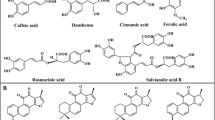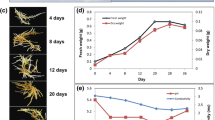Abstract
Salvia miltiorrhiza is one of the most popular traditional Chinese medicinal plants because of its excellent performance in treating coronary heart disease. Tanshinones, a group of active compounds in S. miltiorrhiza, are derived from two biosynthetic pathways: the mevalonate (MVA) pathway in the cytosol and the 2-C-methyl-D-erythritol-4-phosphate (MEP) pathway in the plastids. Water stress is well known to stimulate the accumulation of secondary metabolites in plants. Reactive oxygen species (ROS) serve as important secondary messengers in water stress-induced signal transduction pathways. In this study, the effects of polyethylene glycol (PEG) and abscisic acid (ABA) on tanshinone production in S. miltiorrhiza hairy roots were investigated and the roles of ROS in PEG- and ABA-induced tanshinone production were further elucidated. The results showed that contents and yields of four tanshinones in S. miltiorrhiza hairy roots were significantly enhanced by 2 % PEG and 200 μM ABA. Simultaneously, the mRNA levels and activities of two key enzymes (3-hydroxy-3-methylglutaryl coenzyme A reductase and 1-deoxy-D-xylulose 5-phosphate synthase) involved in tanshinone biosynthesis were upregulated. Both PEG and ABA were able to trigger the burst of H2O2 and O2 −. The PEG- and ABA-induced increases of tanshinone production, gene expression, and enzyme activity were all dramatically suppressed by two ROS scavengers, catalase and superoxide dismutase. In addition, ROS treatments resulted in a significant increase in tanshinone production. These results demonstrated that the MVA and MEP pathways were activated by PEG and ABA to stimulate tanshinone biosynthesis, and the increase of tanshinone production was probably via ROS signaling.




Similar content being viewed by others
References
Apel K, Hirt H (2004) Reactive oxygen species: metabolism, oxidative stress, and signal transduction. Annu Rev Plant Biol 55:373–399
Bailey-Serres J, Mittler R (2006) The roles of reactive oxygen species in plant cells. Plant Physiol 141:311
Blanch JS, Peñuelas J, Sardans J, Llusià J (2009) Drought, warming and soil fertilization effects on leaf volatile terpene concentrations in Pinus halepensis and Quercus ilex. Acta Physiol Plant 31:207–218
Boo YC, Jung J (1999) Water deficit-induced oxidative stress and antioxidative defenses in rice plants. J Plant Physiol 155:255–261
Chen H, Chen F (1999) Effects of methyl jasmonate and salicylic acid on cell growth and cryptotanshinone formation in Ti transformed Salvia miltiorrhiza cell suspension cultures. Biotechnol Lett 21:803–807
Cruz de Carvalho MH (2008) Drought stress and reactive oxygen species: production, scavenging and signaling. Plant Signal Behav 3:156–165
Dai Z, Cui G, Zhou SF, Zhang X, Huang L (2011) Cloning and characterization of a novel 3-hydroxy-3-methylglutaryl coenzyme A reductase gene from Salvia miltiorrhiza involved in diterpenoid tanshinone accumulation. J Plant Physiol 168:148–157
Gagné S, Cluzet S, Mérillon J-M, Gény L (2011) ABA initiates anthocyanin production in grape cell cultures. J Plant Growth Regul 30:1–10
Ge X, Wu J (2005) Tanshinone production and isoprenoid pathways in Salvia miltiorrhiza hairy roots induced by Ag+ and yeast elicitor. Plant Sci 168:487–491
Hartmann T (2007) From waste products to ecochemicals: fifty years of research of plant secondary metabolism. Phytochemistry 68:2831–2846
Hu ZB, Alfermann AW (1993) Diterpenoid production in hairy root cultures of Salvia miltiorrhiza. Phytochemistry 32:699–703
Hu XY, Neill S, Cai WM, Tang ZC (2003) Hydrogen peroxide and jasmonic acid mediate oligogalacturonic acid-induced saponin accumulation in suspension-cultured cells of Panax ginseng. Physiol Plant 118:414–421
Hu XL, Liu RX, Li YH, Wang W, Tai FJ, Xue RL, Li CH (2010) Heat shock protein 70 regulates the abscisic acid-induced antioxidant response of maize to combined drought and heat stress. Plant Growth Regul 60:225–235
Kai G, Xu H, Zhou C, Liao P, Xiao J, Luo X, You L, Zhang L (2011) Metabolic engineering tanshinone biosynthetic pathway in Salvia miltiorrhiza hairy root cultures. Metab Eng 13:319–327
Lacampagne S, Gagné S, Gény L (2010) Involvement of abscisic acid in controlling the proanthocyanidin biosynthesis pathway in grape skin: new elements regarding the regulation of tannin composition and leucoanthocyanidin reductase (LAR) and anthocyanidin reductase (ANR) activities and expression. J Plant Growth Regul 29:81–90
Leshem Y, Golani Y, Kaye Y, Levine A (2010) Reduced expression of the v-SNAREs AtVAMP71/AtVAMP7C gene family in Arabidopsis reduces drought tolerance by suppression of abscisic acid-dependent stomatal closure. J Exp Bot 61:2615–2622
Lichtenthaler HK (2000) Non-mevalonate isoprenoid biosynthesis: enzymes, genes and inhibitors. Biochem Soc Trans 28:785–789
Liu H, Wang X, Wang D, Zou Z, Liang Z (2011) Effect of drought stress on growth and accumulation of active constituents in Salvia miltiorrhiza bunge. Ind Crop Prod 33:84–88
Mansouri H, Asrar Z, Szopa J (2009) Effects of ABA on primary terpenoids and Delta (9)-tetrahydrocannabinol in Cannabis sativa L. at flowering stage. Plant Growth Regul 58:269–277
Miller G, Suzuki N, Ciftci-Yilmaz S, Mittler R (2010) Reactive oxygen species homeostasis and signalling during drought and salinity stresses. Plant, Cell Environ 33:453–467
Oh MM, Trick HN, Rajashekar CB (2009) Secondary metabolism and antioxidants are involved in environmental adaptation and stress tolerance in lettuce. J Plant Physiol 166:180–191
Preston TJ, Muller WJ, Singh G (2001) Scavenging of extracellular H2O2 by catalase inhibits the proliferation of HER-2/Neu-transformed rat-1 fibroblasts through the induction of a stress response. J Biol Chem 276:9558–9564
Rohmer M (1999) The discovery of a mevalonate-independent pathway for isoprenoid biosynthesis in bacteria, algae and higher plants. Nat Prod Rep 16:565–574
Sugiyama A, Zhu BM, Takahara A, Satoh Y, Hashimoto K (2002) Cardiac effects of Salvia miltiorrhiza/Dalbergia odorifera mixture, an intravenously applicable Chinese medicine widely used for patients with ischemic heart disease in China. Circ J 66:182–184
Sun Q, Hu JJ (2006) Reasearch technology of plant physiology. In: Lin L, Hu JJ (eds) Determination of superoxide anion in plants. Northwest A&F University Press, Yangling, pp 174–176
Wang DH, Du F, Liu HY, Liang ZS (2010) Drought stress increases iridoid glycosides biosynthesis in the roots of Scrophularia ningpoensis seedlings. J Med Plants Res 4:2691–2699
Wu SJ, Shi M, Wu JY (2009) Cloning and characterization of the 1-deoxy-D-xylulose 5-phosphate reductoisomerase gene for diterpenoid tanshinone biosynthesis in Salvia miltiorrhiza (Chinese sage) hairy roots. Biotechnol Appl Biochem 52:89–95
Xu MJ, Dong JF (2005) O2− from elicitor-induced oxidative burst is necessary for triggering phenylalanine ammonia-lyase activation and catharanthine synthesis in Catharanthus roseus cell cultures. Enzyme Microb Tech 36:280–284
Yang D, Yang S, Zhang Y, Liu Y, Meng X, Liang Z (2009a) Metabolic profiles of three related Salvia species. Fitoterapia 80:274–278
Yang DF, Liang ZS, Liu JL (2009b) LC fingerprinting for assessment of the quality of the lipophilic components of Salvia miltiorrhiza. Chromatographia 69:555–560
Zhang J, Jia W, Yang J, Ismail AM (2006) Role of ABA in integrating plant responses to drought and salt stresses. Field Crops Res 97:111–119
Zhao JL, Zhou LG, Wu JY (2010) Effects of biotic and abiotic elicitors on cell growth and tanshinone accumulation in Salvia miltiorrhiza cell cultures. Appl Microbiol Biotechnol 87:137–144
Zhu Z, Liang Z, Han R (2009) Saikosaponin accumulation and antioxidative protection in drought-stressed Bupleurum chinense DC plants. Environ Exp Bot 66:326–333
Acknowledgment
This work was supported by the Knowledge Innovation Project of the Chinese Academy of Science (KZCX2-YW-443).
Author information
Authors and Affiliations
Corresponding author
Additional information
D. Yang, D. Sheng, and Q. Duan contributed equally to this work.
Rights and permissions
About this article
Cite this article
Yang, D., Sheng, D., Duan, Q. et al. PEG and ABA Trigger the Burst of Reactive Oxygen Species to Increase Tanshinone Production in Salvia miltiorrhiza Hairy Roots. J Plant Growth Regul 31, 579–587 (2012). https://doi.org/10.1007/s00344-012-9268-6
Received:
Accepted:
Published:
Issue Date:
DOI: https://doi.org/10.1007/s00344-012-9268-6




